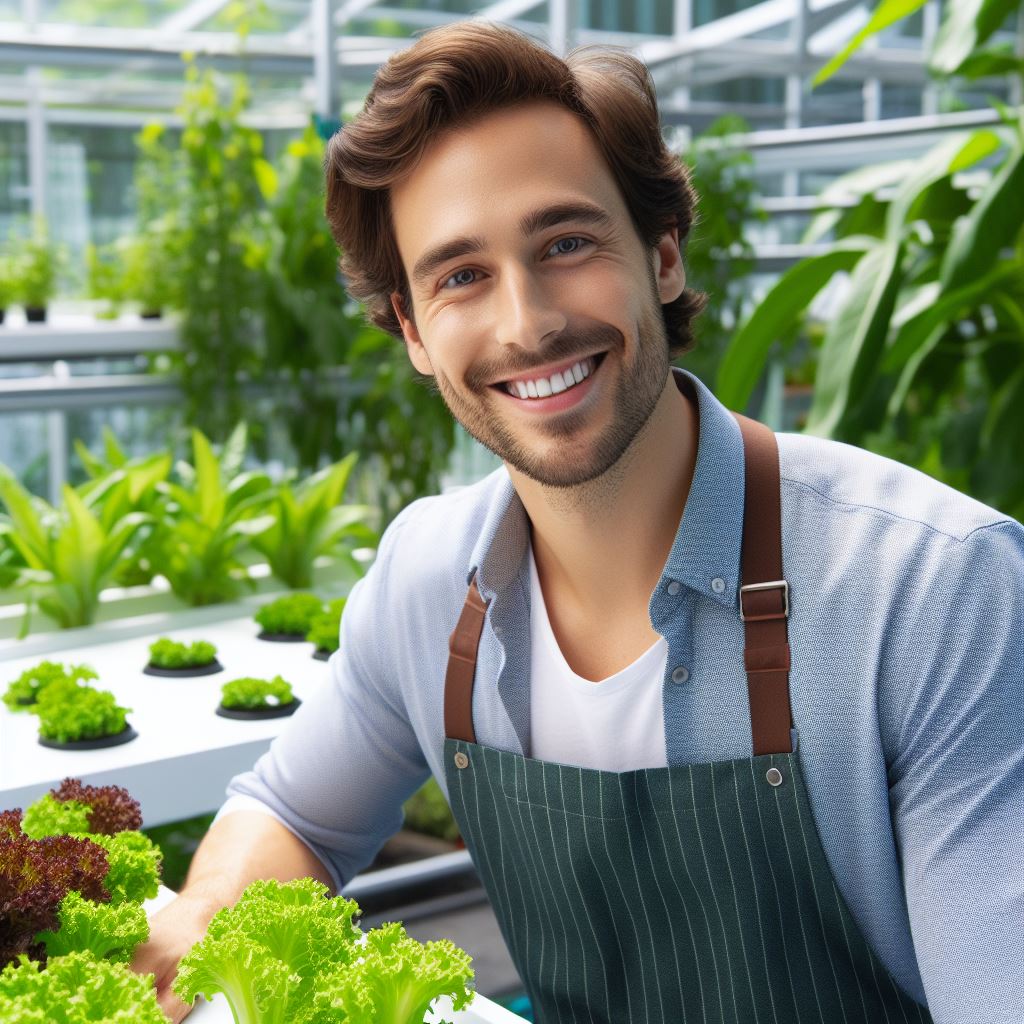Introduction
Innovative and sustainable, hydroponic growing revolutionizes farming.
Without soil, plants thrive in nutrient-rich water solutions, ensuring efficient cultivation.
Hydroponics offers numerous benefits, from water conservation to accelerated growth.
It maximizes space utilization and minimizes environmental impact, making it an eco-friendly alternative.
The controlled environment reduces the risk of pests and diseases, resulting in healthier crops.
Hydroponics plays a crucial role in addressing global food challenges.
With its ability to produce crops year-round, regardless of climate conditions, it ensures a consistent food supply.
This method also requires less water than traditional farming, addressing water scarcity concerns.
The streamlined process significantly reduces the need for pesticides and herbicides, promoting cleaner and safer produce.
In essence, hydroponic growing transforms how we perceive and practice agriculture.
The thesis is clear: Hydroponics is a groundbreaking approach that not only enhances farming efficiency but also yields fresh, nutritious, and sustainable produce.
This method propels us toward a future where our tables are adorned with vibrant, locally grown crops, cultivated through a pioneering and environmentally conscious method.
History of Hydroponic Growing
Origins of hydroponics
Hydroponics, the practice of growing plants without soil, dates back to ancient civilizations such as the Hanging Gardens of Babylon.
The Aztecs also utilized a form of hydroponics called chinampas to grow crops on floating rafts in lakes.
In the 17th century, Sir Francis Bacon experimented with growing plants in water, foreshadowing modern hydroponics.
Development and improvements over time
It wasn’t until the 19th century that scientists began to truly explore and understand the science behind hydroponics.
In the 1930s, William Frederick Gericke coined the term “hydroponics” and conducted extensive research, leading to its widespread adoption.
NASA’s experiments on hydroponic gardening during the late 20th century further advanced the technology.
Impact on modern agriculture
Hydroponics has revolutionized modern agriculture by offering numerous benefits over traditional soil-based farming methods.
It allows for controlled and optimized plant growth by providing essential nutrients directly to the roots.
Hydroponic systems require less water compared to conventional farming, making it an environmentally friendly alternative.
The absence of soil also eliminates many pests and diseases, reducing the need for harmful pesticides.
Furthermore, hydroponic growing enables year-round cultivation, making it possible to grow crops in any climate and location.
Urban farming has also been greatly enhanced by hydroponics, as these systems can be easily incorporated into limited spaces.
Hydroponic farming has the potential to combat food insecurity by providing fresh produce locally, reducing transportation costs.
The development of hydroponics has led to the emergence of vertical farming, where plants are grown in vertical stacks.
This innovative approach maximizes space utilization and increases crop yields, making it ideal for urban environments.
Hydroponic techniques are also being applied to cultivation methods such as aeroponics and aquaponics, expanding the possibilities even further.
In addition to its impact on traditional agriculture, hydroponics has found applications in research, education, and sustainable living.
Scientists use hydroponics to study plant behavior and develop new varieties with improved traits.
Educational institutions utilize hydroponics as a hands-on learning tool, allowing students to understand plant biology and sustainable farming.
Hydroponics is also a cornerstone in sustainable living practices, as it minimizes water usage and reduces the environmental footprint of food production.
In short, the history of hydroponic growing spans centuries, from ancient civilizations to modern technological advancements.
The origins of hydroponics can be traced back to innovative societies and visionary scientists.
Over time, hydroponics has evolved and improved, transforming modern agriculture and offering endless possibilities for the future.
How Hydroponic Growing Works
Explanation of the hydroponic system
Hydroponic growing is a method of cultivating plants without soil, using a nutrient-rich water solution.
Different types of hydroponic systems (e.g., NFT, DWC, Drip)
There are various types of hydroponic systems, such as Nutrient Film Technique (NFT), Deep Water Culture (DWC), and Drip system.
Nutrient-rich water as the key element
In hydroponics, plants receive necessary nutrients through water, which is enriched with all the essential elements.
Factors influencing plant growth in hydroponics (e.g., light, temperature, pH)
Several factors play a crucial role in hydroponic plant growth, including adequate light, optimum temperature, and balanced pH levels.
Comparison with traditional soil-based farming
Hydroponic growing offers numerous advantages over traditional soil-based farming methods.
Transform Your Agribusiness
Unlock your farm's potential with expert advice tailored to your needs. Get actionable steps that drive real results.
Get Started- Water efficiency: Hydroponics uses significantly less water compared to soil-based farming.
- Space efficiency: Hydroponic systems can be set up in small spaces, maximizing land utilization.
- Greater crop yield: With precise control of nutrients, light, and other environmental factors, hydroponics often results in higher yields.
- Reduced pesticide use: Hydroponics eliminates the need for pesticides, creating healthier and safer crops.
- Faster growth: Plants in hydroponic systems tend to grow faster since they don’t have to search for nutrients in the soil.
- Year-round cultivation: Hydroponics allows for year-round cultivation, irrespective of seasonal changes.
- Less soil erosion: Since hydroponic systems don’t require soil, there is no risk of soil erosion.
Hydroponic growing has gained popularity in recent years due to its numerous benefits and the ability to grow fresh produce in urban areas with limited space.
By understanding the hydroponic system and its various types, it becomes evident why this method is revolutionizing the way we grow our food.
Read: Vertical Gardens: Maximize Your Space
Advantages of Hydroponic Growing
Hydroponic growing offers numerous advantages over traditional soil-based agriculture.
In this section, we will explore the various benefits of hydroponics, such as water efficiency and conservation, fewer pests and diseases, year-round crop production, optimal nutrient control and absorption, higher crop yields and faster growth, absence of agricultural runoff or soil erosion, and the utilization of limited space for urban gardening.
Water efficiency and conservation
Hydroponic systems are known for their excellent water efficiency.
Compared to traditional soil-based cultivation methods, hydroponics uses up to 90% less water.
This significant reduction in water usage is achieved by recycling and recirculating the nutrient solution, minimizing wastage.
In an era of increasing water scarcity, hydroponics presents a sustainable solution for efficient water utilization and conservation.
Fewer pests and diseases
One of the major advantages of hydroponic growing is the reduced occurrence of pests and diseases.
Since hydroponic plants are not grown in soil, they are less susceptible to soil-borne pests, weeds, and diseases.
This eliminates the need for harmful pesticides and herbicides, making hydroponics an environmentally friendly method of cultivation.
Year-round crop production
Unlike traditional farming practices that are heavily influenced by seasonal changes and climate, hydroponic growing allows for year-round crop production.
By providing a controlled environment, hydroponic systems offer a reliable and consistent growing environment irrespective of external factors like temperature, sunlight, or rainfall.
This flexibility ensures a continuous supply of fresh produce, regardless of the time of year.
Optimal nutrient control and absorption
Hydroponics provides precise control over nutrient supply to plants.
By directly supplying the nutrient solution to the plant roots, hydroponic systems ensure optimal absorption and utilization by the plants, leading to enhanced growth rates.
Growers can tailor the nutrient mix to meet the specific needs of different crops, resulting in healthier plants and higher yields.
Higher crop yields and faster growth
Hydroponic plants experience accelerated growth rates compared to their soil-grown counterparts.
With a constant supply of nutrients and water, hydroponic systems create an ideal growing environment that maximizes plant growth.
This faster growth translates into higher crop yields, enabling growers to produce more food in less time and with fewer resources.
No agricultural runoff or soil erosion
Traditional farming methods often contribute to agricultural runoff and soil erosion, leading to environmental degradation.
Hydroponics eliminates these concerns as it does not rely on soil.
Since plants are grown in inert media or nutrient-rich water, there is no risk of fertilizer runoff or erosion, making hydroponics a sustainable and environmentally friendly approach.
Urban gardening and limited space utilization
Hydroponics is particularly suitable for urban gardening and areas with limited space for traditional farming.
With hydroponics, it is possible to grow plants in urban settings like rooftops, balconies, or small gardens.
Vertical farming, a practice that involves growing plants in stacked layers, is gaining popularity in urban areas, allowing for efficient space utilization and maximizing production in a limited area.
In essence, hydroponic growing offers several advantages compared to traditional soil-based cultivation.
The water efficiency and conservation, reduced pest and disease risks, year-round crop production, optimal nutrient control, higher crop yields, absence of agricultural runoff or soil erosion, and its suitability for urban gardening make hydroponics an innovative and sustainable method of food production.
Read: Compact Composting: Urban Eco Tips
Popular Hydroponic Crops
Hydroponic farming provides the perfect environment for a wide range of crops, including:
- Leafy greens, such as lettuce, spinach, and kale.
- Flavorful herbs like basil, thyme, and mint.
- Delicious tomatoes and cucumbers.
- Refreshing strawberries and other berries.
- Colorful flowers and ornamental plants.
These crops benefit from the controlled settings of hydroponics, resulting in faster growth, higher yields, and enhanced quality compared to traditional soil-based cultivation methods.
Leafy greens
Hydroponic leafy greens, including lettuce, spinach, and kale, excel in hydroponic systems due to their ability to thrive in limited space and rapid growth rate.
The controlled environment allows for optimized nutrient and water delivery, creating healthier and tastier greens.
Herbs (e.g., basil, thyme, mint)
Herbs, such as basil, thyme, and mint, also flourish in hydroponics.
The absence of soil-borne pests and diseases ensures robust herb plants that provide flavorsome additions to various culinary dishes.
With a hydroponic herb garden, fresh herbs are readily available for everyday use.
Tomatoes and cucumbers
Tomatoes and cucumbers are popular hydroponic crops due to the improved quality and yield they produce.
The controlled conditions in hydroponic systems promote healthier plants and reduce the risk of soil-related issues.
The result is more flavorful and nutritious tomatoes and cucumbers.
Strawberries and other berries
Strawberries and other berries have found success in hydroponic farming.
Hydroponic strawberry production allows for year-round cultivation, protection against soil-borne diseases, and improved pest management.
This means a consistent supply of delicious, sweet berries for consumers.
Flowers and ornamental plants
In addition to food crops, hydroponics has also revolutionized the floral industry by enabling efficient growth of flowers and ornamental plants.
Orchids, with their delicate and vibrant blooms, greatly benefit from hydroponic systems.
The optimal nutrient delivery and environmental control lead to stronger plants and longer-lasting flowers.
Overall, hydroponic growing opens up endless possibilities for cultivating a variety of crops.
From leafy greens and herbs to juicy fruits and colorful flowers, hydroponics offers numerous advantages in terms of yield, quality, and sustainability.
Read: Rooftop Gardens: Sky-High Greenery

Challenges and Limitations of Hydroponic Growing
Achieving success in hydroponic growing comes with its fair share of challenges and limitations.
Let’s explore some of them:
Initial setup cost
- The initial investment required to set up a hydroponic system can be quite expensive.
- Purchasing equipment such as grow lights, pumps, and nutrient solutions can quickly add up.
Technical knowledge and expertise required
- Hydroponic growing requires a good understanding of plant biology, nutrient solutions, and water management.
- Growers need to know how to balance nutrients, pH levels, and temperature to ensure optimal growth.
Equipment maintenance and monitoring
- Hydroponic systems require regular monitoring and maintenance to prevent issues such as clogged pumps or nutrient imbalances.
- Growers need to regularly check pH levels, nutrient concentrations, and water levels to keep plants healthy.
Dependence on energy sources
- Hydroponic systems heavily rely on energy sources to power grow lights, pumps, and other equipment.
- High energy consumption can increase production costs and have environmental impacts.
Limited crop diversity and root system development
- Not all crops thrive in hydroponic systems, limiting the variety of plants that can be grown.
- Certain plants with extensive root systems may struggle to anchor themselves properly in a hydroponic setup.
Despite these challenges, many hydroponic growers find ways to overcome them and achieve successful harvests.
By implementing efficient management practices, investing in advanced technologies, and continuously improving their knowledge, growers can overcome the limitations of hydroponics.
Showcase Your Farming Business
Publish your professional farming services profile on our blog for a one-time fee of $200 and reach a dedicated audience of farmers and agribusiness owners.
Publish Your ProfileIt’s important to factor in these challenges when considering hydroponic growing, but the benefits such as faster growth, higher yields, and year-round production often outweigh the difficulties.
Additionally, ongoing research and development are focused on addressing these limitations and making hydroponic systems more accessible and sustainable.
The future of hydroponic growing looks promising as growers and researchers work together to overcome challenges and push the boundaries of this innovative farming method.
With continuous advancements, hydroponics has the potential to revolutionize our food production systems and contribute to a more sustainable and self-sufficient future.
Read: Urban Farming: Small Plot, Big Yield
Success Stories and Examples
Successful hydroponic farms and projects worldwide
- Gotham Greens: A pioneering hydroponic farm in Brooklyn that produces high-quality, pesticide-free greens.
- AeroFarms: Using vertical farming techniques, they have transformed abandoned warehouses into highly productive hydroponic farms.
- LettUs Grow: This UK-based company focuses on precision farming and has developed innovative hydroponic systems.
- BrightFarms: They build and operate hydroponic greenhouses near major cities, providing year-round local produce.
- Plenty: With their advanced indoor farming technology, Plenty grows a wide variety of crops sustainably.
Benefits and impact on local communities
- Decreased environmental impact: Hydroponics use up to 90% less water and land compared to traditional farming.
- Increased food production: By optimizing growing conditions, hydroponics can yield higher crop yields.
- Fresh and nutritious food: Local communities can access fresh produce that is free from pesticides and transportation delays.
- Job creation: Hydroponic farms require skilled workers, contributing to employment opportunities in the community.
- Food security: Hydroponics can enhance food availability, reducing reliance on imported produce.
Case study: Hydroponic farms in urban areas
- Detroit, Michigan: Urban Agriculture Inc. operates several hydroponic farms in abandoned buildings, revitalizing the city’s economy and providing fresh food to residents.
- Singapore: The Sky Greens vertical farm maximizes land utilization and boosts local food production in this densely populated city-state.
- Berlin, Germany: Infarm operates modular hydroponic systems in supermarkets, bringing ultra-fresh herbs and vegetables directly to consumers.
- Tokyo, Japan: Pasona O2 is an underground hydroponic garden in an office building, promoting sustainable agriculture in the city center.
- Toronto, Canada: Growing Underground uses hydroponics in a converted tunnel system, offering locally grown greens year-round.
In review, hydroponic farming has gained global recognition for its success stories and positive impacts.
Farms like Gotham Greens, AeroFarms, and LettUs Grow showcase the potential of hydroponics.
The benefits, including decreased environmental impact and increased food production, have a profound effect on local communities.
Case studies in urban areas demonstrate how hydroponics can transform abandoned spaces into flourishing farms, promote food security, and contribute to sustainable agriculture.
The examples mentioned above highlight the importance of embracing hydroponic growing as a solution for the future.
Uncover the Details: Plant Diseases: Identification & Control
The Future of Hydroponic Growing
Hydroponic growing has emerged as a sustainable and efficient method of cultivation that offers numerous advantages over traditional farming practices.
As advancements continue to be made in this field, the future of hydroponic growing is very promising, with the potential for significant impact in various areas.
Continued advancements in hydroponic technology
Hydroponic technology has come a long way in recent years and is continuously evolving.
Ongoing research and innovation are leading to the development of more efficient systems that optimize plant growth and resource utilization.
Scientists and engineers are constantly exploring new techniques and technologies to improve nutrient delivery, lighting, and climate control in hydroponic systems.
The goal is to create the most optimal environment for plants to thrive in, ensuring higher yields and better quality produce.
These advancements include the use of sensors and automation to monitor and adjust environmental conditions, as well as the development of new nutrient formulations and delivery methods.
These technological advancements will further revolutionize hydroponic growing in the future.
Potential integration with other sustainable farming practices
Hydroponic growing has the potential to integrate with other sustainable farming practices, such as aquaponics and vertical farming.
By combining these methods, farmers can maximize space utilization and resource efficiency.
Aquaponics, for instance, involves the cultivation of plants in a symbiotic relationship with fish.
The fish waste provides essential nutrients for the plants, while the plants help filter and clean the water for the fish.
Integrating aquaponics with hydroponics allows for a closed-loop system where waste from one process becomes a resource for another.
Vertical farming, on the other hand, utilizes vertical space to grow crops in stacked layers, using artificial lighting.
By combining hydroponics with vertical farming, farmers can maximize land use, reduce transportation costs, and produce food closer to urban centers, minimizing the carbon footprint associated with food production and distribution.
Adoption and scalability in commercial agriculture
While hydroponic growing has traditionally been used on a smaller scale, there is increasing interest in its adoption on a commercial level.
Large-scale hydroponic farms have the potential to revolutionize the agricultural industry by providing a consistent supply of fresh produce regardless of external factors such as climate or soil quality.
Scalability is a crucial aspect of hydroponic farming, as it allows for increased production without compromising the efficiency and sustainability of the system.
Commercial hydroponic farms can be designed to accommodate high-density planting and automated processes, further optimizing resource utilization and reducing labor requirements.
Furthermore, the controlled environment of hydroponic systems provides the opportunity for year-round crop production.
This constant supply of fresh produce can greatly reduce the dependency on seasonal farming and help meet the growing demand for food in an ever-expanding global population.
Impact on food security and global food production
Hydroponic growing holds significant promise in addressing the global challenges of food security and production.
By eliminating the need for arable land and minimizing water usage, hydroponics can help overcome limitations associated with traditional farming.
With a growing world population and diminishing resources, hydroponics offers a sustainable solution to produce food in urban areas, where farming opportunities are limited.
By growing food closer to the consumers, the carbon footprint associated with transportation and storage is reduced, ensuring a more environmentally friendly and efficient food system.
The ability to control the growing environment also reduces the risk of crop failure due to extreme weather conditions or pests, ensuring a more reliable food supply.
Additionally, hydroponic systems require fewer pesticides and herbicides, making the produce healthier and safer for consumption.
In a nutshell, the future of hydroponic growing is bright and full of potential.
Continued advancements in technology, integration with other sustainable farming practices, adoption in commercial agriculture, and impact on food security and global food production make hydroponics a crucial player in ensuring a sustainable and secure food supply for the future.
Conclusion
Hydroponic growing provides a solution to the limited availability of arable land, conserves water and nutrients, reduces the need for pesticides, and allows for year-round cultivation.
Furthermore, it promotes local food production, enables vertical farming in urban areas, and enhances food security by reducing dependence on imports.
To truly reap the benefits of hydroponics, it is crucial for individuals and communities to educate themselves about the various systems and techniques available.
By supporting local hydroponic farms, investing in research and development, and advocating for sustainable agriculture practices, we can contribute to the growth and success of this innovative farming method.
Looking ahead, the future of hydroponic growing is promising.
The advancements in technology and our increasing understanding of plant biology continue to expand the possibilities of this farming technique.
As we face a growing global population and the challenges of climate change, hydroponics offers a practical solution to ensure a reliable and sustainable food supply.
Let us embrace hydroponics and work towards creating a future where fresh, nutritious food is accessible to all, and our agriculture practices align with environmental stewardship.




